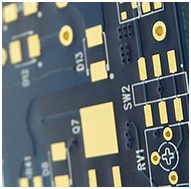In PCB application, all gold is 99.9% pure. So efficiency in selecting the most appropriate process and thickness is very important to keep your product as cost-effective as possible. There are multiple types of gold finishes which can be applied to printed circuit boards, depending on the functionality required.
ENIG (Electroless Nickel plating under Immersion Gold plating)
The most popular surface finish used by designers is a soft gold. Generally processed to a thickness of 1-3 micro-inches. Electroless nickel immersion gold (ENIG) as a surface finish has good oxidation resistance and can be deposited uniformly and flat which is an advantage during assembly operations, especially for fine-pitch SMD parts.

Adding additional gold, say to 4-8 micro inches is often suggested, however, the primary purpose of ENIG gold is to protect the nickel underplate while providing a good solderable surface finish. Per IPC-4552, increase the thickness of gold may compromise the underlying nickel plating, so should be avoided.
ENEPIG (Electroless Nickel Electroless Palladium Immersion Gold)
Electroless nickel electroless palladium immersion gold (ENEPIG) is similar to ENIG with the addition of palladium to the alloy. The purpose of the palladium was to address two early concerns with ENIG (non-wetting and “black pads”). ENEPIG finish did not take off as expected, adding cost and necessitating a separate processing line. This finish increased processing times and prices (35-60% depending on volume). ENEPIG has some advantages for wire bonding and shelf life but comes at a price.
Gold edge contacts or fingers, have different applications. Some for an edge card connection (plugged into a connector on a mother board). A card that is inserted and left for the longevity of its life cycle may have an immersion surface where a card that is inserted and removed repeatedly should have a hard, gold-plated surface for wear resistance.

If a PCB is to be used in combination with a membrane switch, then the underlying gold pads must withstand many actuation forces of a key depression. These are usually defined up to 200-300 micro inches of “hard gold.” Hard gold is meant to survive many actuation forces or insertion and removal up to 1,000 actuations or more.